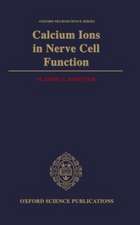Neuroanatomy and Pathology of Sporadic Alzheimer's Disease: Advances in Anatomy, Embryology and Cell Biology, cartea 215
Autor Heiko Braak, Kelly Del Tredicien Limba Engleză Paperback – 23 dec 2014
Din seria Advances in Anatomy, Embryology and Cell Biology
- 5%
 Preț: 1146.33 lei
Preț: 1146.33 lei - 5%
 Preț: 721.19 lei
Preț: 721.19 lei - 15%
 Preț: 637.13 lei
Preț: 637.13 lei -
 Preț: 381.81 lei
Preț: 381.81 lei - 15%
 Preț: 644.95 lei
Preț: 644.95 lei - 5%
 Preț: 1025.16 lei
Preț: 1025.16 lei - 15%
 Preț: 689.97 lei
Preț: 689.97 lei - 15%
 Preț: 577.07 lei
Preț: 577.07 lei - 15%
 Preț: 580.36 lei
Preț: 580.36 lei - 5%
 Preț: 393.51 lei
Preț: 393.51 lei -
 Preț: 408.66 lei
Preț: 408.66 lei -
![Die Schlüpfdrüse der Geburtshelferkröte (Alytes o. obstetricans [LAURENTI]) und anderer Froschlurche](https://i4.books-express.ro/bs/9783662239742/die-schluepfdruese-der-geburtshelferkroete-alytes-o-obstetricans-laurenti-und-anderer-froschlurche.jpg) Preț: 408.27 lei
Preț: 408.27 lei - 5%
 Preț: 1090.61 lei
Preț: 1090.61 lei - 5%
 Preț: 705.11 lei
Preț: 705.11 lei - 5%
 Preț: 706.04 lei
Preț: 706.04 lei - 5%
 Preț: 357.61 lei
Preț: 357.61 lei - 5%
 Preț: 704.59 lei
Preț: 704.59 lei - 5%
 Preț: 705.11 lei
Preț: 705.11 lei - 5%
 Preț: 359.42 lei
Preț: 359.42 lei - 5%
 Preț: 711.52 lei
Preț: 711.52 lei - 15%
 Preț: 635.47 lei
Preț: 635.47 lei - 15%
 Preț: 631.72 lei
Preț: 631.72 lei - 15%
 Preț: 633.35 lei
Preț: 633.35 lei - 15%
 Preț: 632.37 lei
Preț: 632.37 lei - 5%
 Preț: 706.60 lei
Preț: 706.60 lei - 15%
 Preț: 631.07 lei
Preț: 631.07 lei - 5%
 Preț: 707.13 lei
Preț: 707.13 lei - 5%
 Preț: 707.33 lei
Preț: 707.33 lei - 5%
 Preț: 359.60 lei
Preț: 359.60 lei - 5%
 Preț: 707.69 lei
Preț: 707.69 lei - 5%
 Preț: 707.13 lei
Preț: 707.13 lei - 5%
 Preț: 708.06 lei
Preț: 708.06 lei - 5%
 Preț: 706.41 lei
Preț: 706.41 lei - 5%
 Preț: 708.78 lei
Preț: 708.78 lei - 5%
 Preț: 705.68 lei
Preț: 705.68 lei - 5%
 Preț: 705.11 lei
Preț: 705.11 lei - 5%
 Preț: 706.77 lei
Preț: 706.77 lei - 15%
 Preț: 635.15 lei
Preț: 635.15 lei - 15%
 Preț: 631.07 lei
Preț: 631.07 lei - 5%
 Preț: 706.77 lei
Preț: 706.77 lei - 5%
 Preț: 706.04 lei
Preț: 706.04 lei - 5%
 Preț: 710.79 lei
Preț: 710.79 lei - 5%
 Preț: 705.32 lei
Preț: 705.32 lei - 15%
 Preț: 633.19 lei
Preț: 633.19 lei - 15%
 Preț: 629.09 lei
Preț: 629.09 lei - 15%
 Preț: 633.53 lei
Preț: 633.53 lei - 15%
 Preț: 632.70 lei
Preț: 632.70 lei - 15%
 Preț: 633.68 lei
Preț: 633.68 lei - 18%
 Preț: 773.72 lei
Preț: 773.72 lei - 15%
 Preț: 630.43 lei
Preț: 630.43 lei
Preț: 933.44 lei
Preț vechi: 1138.34 lei
-18% Nou
Puncte Express: 1400
Preț estimativ în valută:
178.64€ • 185.81$ • 147.47£
178.64€ • 185.81$ • 147.47£
Carte tipărită la comandă
Livrare economică 15-29 aprilie
Preluare comenzi: 021 569.72.76
Specificații
ISBN-13: 9783319126784
ISBN-10: 3319126784
Pagini: 162
Ilustrații: XI, 162 p. 48 illus., 44 illus. in color.
Dimensiuni: 155 x 235 x 13 mm
Greutate: 0.25 kg
Ediția:2015
Editura: Springer International Publishing
Colecția Springer
Seria Advances in Anatomy, Embryology and Cell Biology
Locul publicării:Cham, Switzerland
ISBN-10: 3319126784
Pagini: 162
Ilustrații: XI, 162 p. 48 illus., 44 illus. in color.
Dimensiuni: 155 x 235 x 13 mm
Greutate: 0.25 kg
Ediția:2015
Editura: Springer International Publishing
Colecția Springer
Seria Advances in Anatomy, Embryology and Cell Biology
Locul publicării:Cham, Switzerland
Public țintă
ResearchCuprins
Prologue.- General Morphology of Alzheimer-associated intraneuronal pathology.- Consistent and systematic changes in the distribution pattern of intraneuronal inclusions render staging possible.- Basic organization of involved structures.- Presymptomatic stages.- General morphology of Alzheimer-associated extracellular pathology.- Symptomatic stages.- The progression of cortical lesions mimics the pattern of myelination in reverse order.- Tauopathies.- CSF biomarkers and imaging techniques.- The staging hypothesis: assumptions, challenges, potential.- Technical considerations.
Textul de pe ultima copertă
As indicated by its title, this monograph deals chiefly with morphologically recognizable deviations from the normal anatomical condition of the human CNS. The AD-associated pathology is illustrated from its beginnings (sometimes even in childhood) to its final form, which is reached late in life. The AD process commences much earlier than the clinically recognizable phase of the disorder, and its timeline includes an extended preclinical phase. The further the pendulum swings away from the symptomatic final stages towards the early pathology, the more obvious the lesions become, although from a standpoint of severity they are more unremarkable and thus frequently overlooked during routine neuropathological assessment. For this reason, the authors deal with the hallmark lesions in the early phases of the AD process in considerable detail.
Caracteristici
Written by experts in the field of Alzheimer's disease Provides excellent anatomical and pathological basis for researchers working with experimental and molecular-biological aspects of Alzheimer's disease Provides an overview on all pathological changes in the central nervous system after the onset of Alzheimer's disease Includes supplementary material: sn.pub/extras















